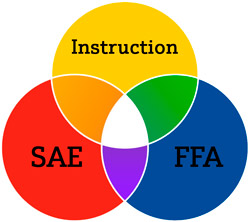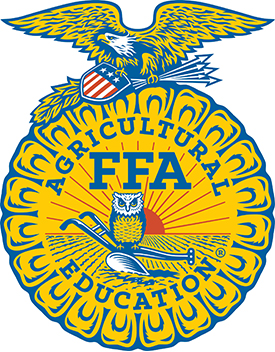|
|
|
|
What is FFA?
|
3-Part Model of Agricultural Education

FFA is not extracurricular! The program is part of a three-part model of education that consists of (1) classroom instruction, (2) supervised agricultural experiences and the (3) FFA.
Classroom agricultural education is applied to hands-on learning opportunities called supervised agricultural experiences (SAEs). SAEs include activities such as starting a business, working for an established company or working in production agriculture.
FFA activities vary greatly from chapter to chapter, but are based in a well-integrated curriculum. Chapter activities and programs concentrate on three areas of the FFA mission: premier leadership, personal growth and career success.
|
FFA Mission
FFA makes a positive difference in the lives of students by developing their potential for premier leadership, personal growth and career success through agricultural education
|
FFA Motto
Learning to do, Doing to learn, Earning to live, Living to serve.
|
FFA Creed
I believe in the future of agriculture, with a faith born not of words but of deeds - achievements won by the present and past generations of agriculturists; in the promise of better days through better ways, even as the better things we now enjoy have come to us from the struggles of former years.
I believe that to live and work on a good farm, or to be engaged in other agricultural pursuits, is pleasant as well as challenging; for I know the joys and discomforts of agricultural life and hold an inborn fondness for those associations which, even in hours of discouragement, I cannot deny.
I believe in leadership from ourselves and respect from others. I believe in my own ability to work efficiently and think clearly, with such knowledge and skill as I can secure, and in the ability of progressive agriculturists to serve our own and the public interest in producing and marketing the product of our toil.
I believe in less dependence on begging and more power in bargaining; in the life abundant and enough honest wealth to help make it so--for others as well as myself; in less need for charity and more of it when needed; in being happy myself and playing square with those whose happiness depends upon me.
I believe that American agriculture can and will hold true to the best traditions of our national life and that I can exert an influence in my home and community which will stand solid for my part in that inspiring task.
The creed was written by E. M. Tiffany, and adopted at the 3rd National Convention of the FFA. It was revised at the 38th Convention and the 63rd Convention.
|
FFA Emblem

The national FFA emblem, consisting of five symbols, is representative of the history, goals, and future of the organization. As a whole, the emblem covers the broad spectrum of FFA and agriculture. Each element within the emblem has unique significance.
The cross section of the ear of corn provides the foundation of the emblem, just as corn has historically served as the foundation crop of American agriculture. It is also a symbol of unity, as corn is grown in every state of the nation.
The rising sun signifies progress and holds a promise that tomorrow will bring a new day glowing with opportunity.
The plow signifies labor and tillage of the soil, the backbone of agriculture and the historic foundation of our country’s strength.
The eagle is a national symbol which serves as a reminder of our freedom and ability to explore new horizons for the future of agriculture.
The owl, long recognized for its wisdom, symbolizes the knowledge required to be successful in the industry of agriculture.
The words "Agricultural Education" and "FFA" are emblazoned in the center to signify the combination of learning and leadership necessary for progressive agriculture.
|
FFA Colors
As the blue field of our nation's flag and the golden fields of ripened corn unify our country, the FFA colors of national blue and corn gold give unity to the organization.
|
|
|
| |
|
The Texas FFA Association was chartered in 1929.
|
|
More than one-third of Texas FFA members are female.
|
|
There are approximately 2,000 agricultural science teachers in Texas. (2015-16)
|
|
Ten state officers, high school seniors, are popularly elected annually by the delegates at the State FFA Convention.
|
|
The state FFA president and first VP take a yearlong leave of absence from college to travel the state representing Texas FFA by visiting 400+ schools; traveling more than 60,000 miles.
|
|
|
|
|
|
|